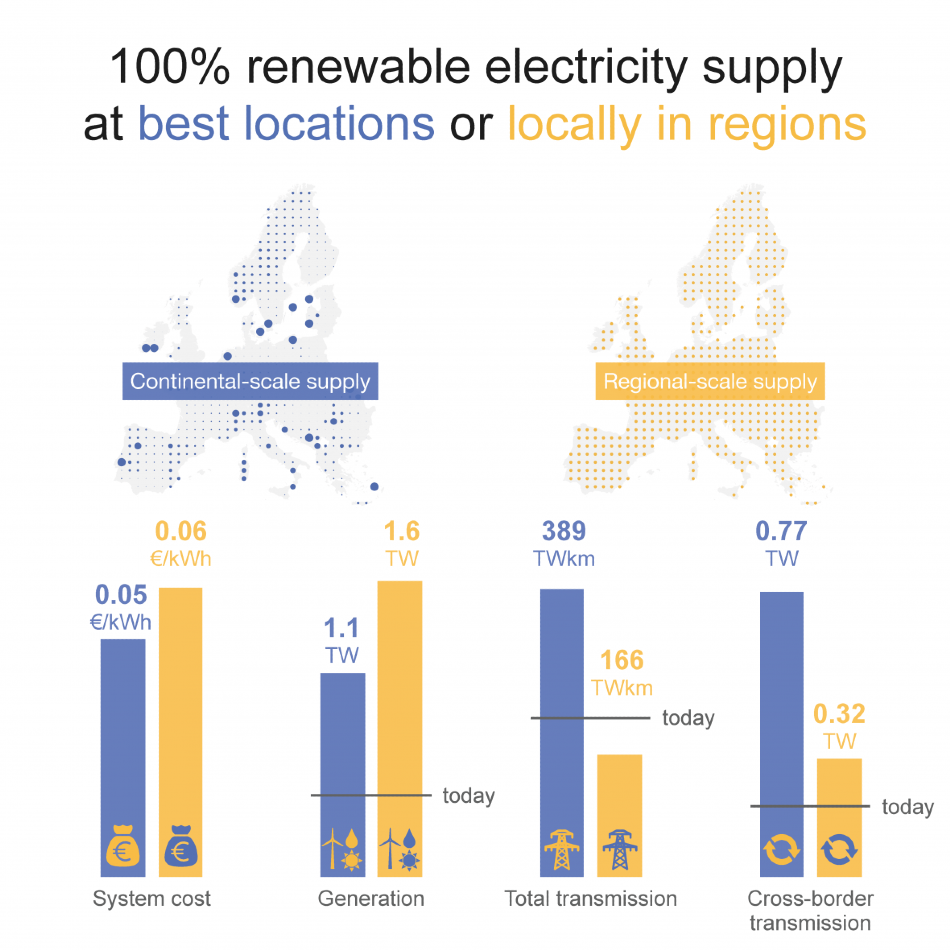Aug 17 2020
The objective of the European Union is to realize climate neutrality by 2050, and it heavily relies on renewable electricity to achieve this goal.
 Comparison of continental-scale supply and regional-scale supply. Image Credit: Tim Tröndle, IASS/ETH Zurich.
Comparison of continental-scale supply and regional-scale supply. Image Credit: Tim Tröndle, IASS/ETH Zurich.
The execution of this energy transition has turned out to be the subject of a hot topic: A continental-scale system that focuses on energy generation infrastructure in the most appropriate locations would offer the most inexpensive solution, but several citizens prefer smaller, more widespread supply networks.
New research by scientists from Potsdam and Zurich illustrates that setting up of such systems would not involve considerable additional costs.
The team analyzed the economic viability and technical possibility of generating renewable electricity at the regional, national, and continental levels. According to Tim Tröndle, the lead author of the study, the aim of the study was to find if smaller electricity supply systems are actually much more costly compared to a continental-scale system.
Proponents of a continental system argue that large-scale solutions are more affordable, enable suppliers to balance fluctuations, and facilitate the efficient use of resources regardless of their location. While these advantages are undeniable, political interests and public acceptance play a significant role in shaping the energy transition. As a result, proper consideration must also be given to smaller systems.
Tim Tröndle, Study Lead Author, Institute for Advanced Sustainability Studies, Potsdam/ETH Zurich
Smaller Scale Systems Incur a Cost Penalty of Less Than 20%
Modeling performed for the study validated the fact that the most cost-effective solution would be to set up an interconnected European grid to supply electricity produced at locations throughout Europe with the best wind and solar resources.
However, the cost penalties associated with smaller systems stay low if suppliers can balance fluctuations in the production of electricity throughout the regions and countries.
In such a case, grid operators can collaborate with partners at the regional and national levels to balance fluctuations through electricity sharing with neighboring grids instead of installing expensive storage technologies or reducing the electricity that is generated from solar and wind plants.
The development of a well-functioning European energy market could decrease cost penalties sustained by small-scale systems to less than 20% in comparison with a continental supply system.
The researchers consider that this finding promotes existing measures to set up a European electricity market and extend the network of cross-border interconnectors that connect national systems, which enable fluctuations to be balanced.
Infrastructure Requirements Vary Significantly
This study reports that the location of electricity generation infrastructure does not have a considerable impact on the cost of totally renewable electricity supply.
However, location significantly impacts infrastructure choices, especially with respect to the question of whether more generation or transmission infrastructure is required. In light of this, the preferred size of power generation systems should be clarified quickly in order to accelerate the energy transition.
Johan Lilliestam, Study Co-Author, Institute for Advanced Sustainability Studies Potsdam, University of Potsdam
There are many viable solutions, varying from a more continental system where electricity generation focuses on the best locations through to several smaller, local systems where electricity is produced close to consumers.
Journal Reference
Tröndle, T., et al. (2020) Trade-Offs between Geographic Scale, Cost, and Infrastructure Requirements for Fully Renewable Electricity in Europe. Joule. doi.org/10.1016/j.joule.2020.07.018.